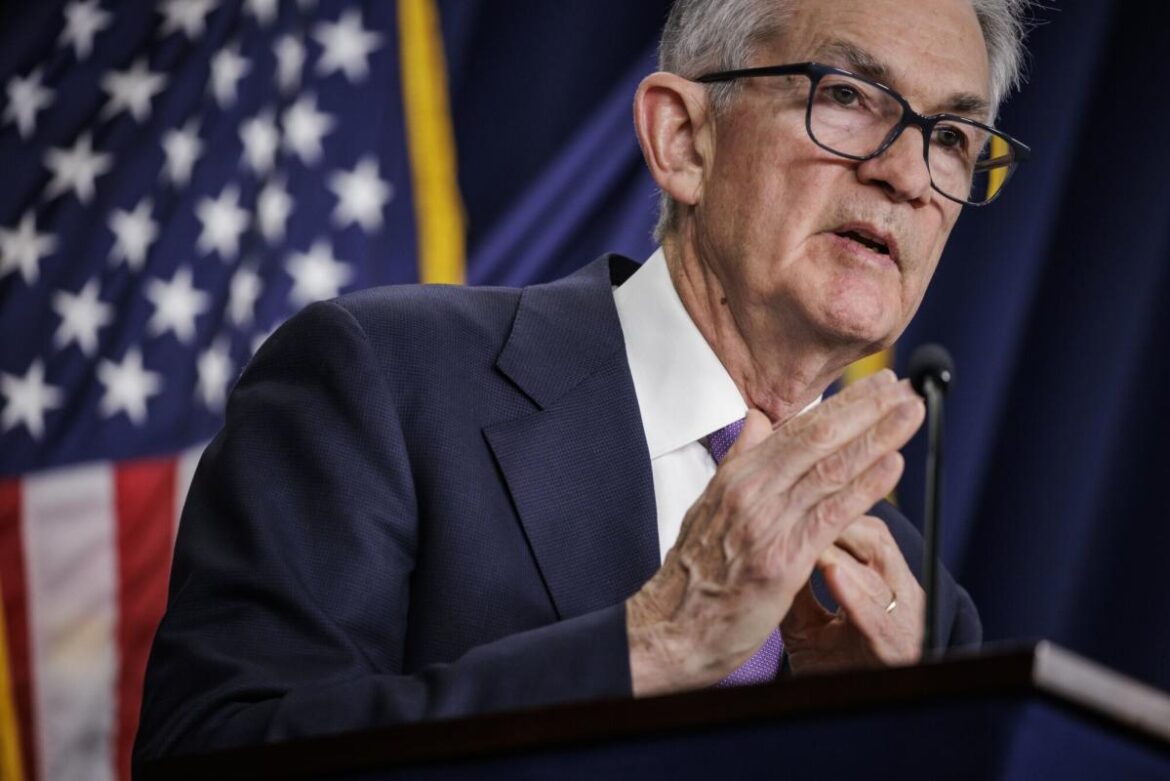
It’s no secret that lots of analysts like tech behemoths like Amazon.com Inc., Microsoft Corp. and Nvidia Corp. amid the AI gold rush. But as of Friday, they liked one just a bit more, at least based on the percentage of ‘buy’ recommendations: Delta Air Lines Inc.
Source link
Corner
Jensen Huang Just Said “Humanoid Robotics Should Be Right Around the Corner.” Here’s How Nvidia Could Benefit.
When it comes to artificial intelligence (AI), applications in machine learning, large language models, and compute networking garner most of the attention. But what investors may not realize is that use cases packaged around AI are evolving in real time.
One area that is getting particular interest is robotics. Indeed, companies such as Amazon and Alibaba have implemented robotics throughout their warehouses for years, creating efficiencies as it relates to packaging and logistics.
However, a rising number of the world’s largest technology companies are increasingly focusing on the next frontier of robotics: humanoid bots. In late February, Nvidia‘s (NVDA -0.12%) CEO, Jensen Huang, said “humanoid robotics should be right around the corner” during a panel discussion about AI.
Let’s dig into the rise of humanoid robotics and analyze the moves Nvidia is making in the space.
How does AI play a role in robotics?
Robotics is an interesting part of the overall AI narrative because it is uniquely positioned at the intersection of software and hardware. And believe it or not, there are lots of companies working to develop humanoid bots.
Two of the more recognized brands in robotics include Boston Dynamics and Tesla. Over the last year, Tesla has teased investors with previews of its humanoid bot Optimus — which is planned to be used across the company’s factories and assembly lines in the future.
One lesser-known robotics start-up called 1X hails from Norway. The company has raised $125 million in venture capital (VC) funding over the last year from high-profile investors including OpenAI, Samsung, and Tiger Global.

Image source: Getty Images.
What is Nvidia doing with robotics?
About a week after Huang’s comments regarding humanoid robots, Nvidia was cited as an investor in a $675 million funding round for start-up Figure AI. Nvidia joined Microsoft, OpenAI, Intel, and Amazon co-founder Jeff Bezos as investors.
Figure AI is developing humanoid robots that it plans to commercialize in industries such as manufacturing, warehousing, and retail. Figure AI’s robots are being trained on generative AI models to learn how to perform basic tasks. The theme? The company is seeking to disrupt the workforce — a market estimated to be worth $42 trillion annually.
How could Nvidia benefit?
Nvidia has incredibly lucrative opportunities in robotics. Currently, the company is primarily a hardware player — developing high-performance semiconductors called graphics processing units (GPUs).
However, Nvidia is quietly expanding outside compute networking. Specifically, the company’s enterprise software and services business is already operating at an annual revenue run rate of $1 billion. While this is impressive, it pales in comparison to Nvidia’s data center business — which generated $47 billion in sales last year.
Moreover, Nvidia is aggressively pursuing the enterprise software market through a combination of investments and strategic partnerships. The company is an investor in start-up Databricks, which largely competes with Palantir Technologies. Additionally, Nvidia also partners with Snowflake, helping bring AI capabilities to the company’s data cloud platform.
Given Nvidia’s distinctive position as both a hardware and software developer, the company has a massive opportunity to play an integral role in the development of humanoid robotics. I see the investment in Figure AI as a first step that could lead to further strategic partnerships and revenue opportunities across both sides of its business.
The important idea here is that Nvidia is subtly building an end-to-end AI solution — spanning across both software and hardware. As such, I think the company is setting itself up for long-term sustained growth in a variety of areas in the overall AI realm.
My guess is that Huang will continue to drop breadcrumbs, alluding to AI-powered applications that he believes Nvidia can play a role in. Despite the run-up in the stock, I think now is a terrific time to scoop up some shares and plan to hold long term.
John Mackey, former CEO of Whole Foods Market, an Amazon subsidiary, is a member of The Motley Fool’s board of directors. Adam Spatacco has positions in Amazon, Microsoft, Nvidia, Palantir Technologies, and Tesla. The Motley Fool has positions in and recommends Amazon, Microsoft, Nvidia, Palantir Technologies, Snowflake, and Tesla. The Motley Fool recommends Alibaba Group and Intel and recommends the following options: long January 2023 $57.50 calls on Intel, long January 2025 $45 calls on Intel, long January 2026 $395 calls on Microsoft, short January 2026 $405 calls on Microsoft, and short May 2024 $47 calls on Intel. The Motley Fool has a disclosure policy.
The Fed’s shrinking balance sheet is worrying a key corner of US financial markets
(Bloomberg) — As markets staged a monster rally following the Federal Reserve’s shift toward loosening monetary policy, one corner of the financial system had reason to remain on edge.
Most Read from Bloomberg
For participants in the overnight funding markets — a key conduit for bank borrowing and linchpin for determining interest rates — Wednesday’s policy meeting contained a more pertinent message from Chair Jerome Powell than the one that sent stocks soaring and pushed the 10-year US yield below 4%: namely, that the Fed’s balance sheet reduction would continue as planned.
A debate is simmering over whether the Fed is misjudging how far it can shrink its balance sheet — a process known as quantitative tightening — without causing dislocations in places like the repurchase-agreement markets, part of the essential plumbing of the financial system. Recent stresses there caused one benchmark rate to hit an all-time high, evoking memories of September 2019, when a different overnight market rate soared five-fold to as high as 10% and the central bank was forced to intervene.
The latest disruptions were indeed of a much lesser degree than four years ago and required no intervention, but both episodes shine a light on the increasingly delicate balance between the Fed, banks and other institutions that helps keep the overnight funding market functioning properly. Four years ago, increased government borrowing exacerbated a shortage of bank reserves that was created when the Fed cut back on Treasury purchases. Now, reserves — the financial “grease” that ensures markets don’t seize up and send rates soaring — and the level at which they become scarce is again in question.

Powell signaled on Wednesday that he was comfortable with the current level of reserves and said the central bank would slow or halt balance-sheet reductions as needed to make sure they remain “somewhat above” a level the Fed considered “ample.” The problem is, it’s unclear what that level is.
“I would be pretty humble because we don’t know,” said former Fed Governor Jeremy Stein, who’s now an economics professor at Harvard University. “Before you bump into the wall it’s very hard to gauge, rather than trying to reassure people we know what we’re doing and can play it pretty close.”
The central bank is keen on shrinking its balance sheet back to the smallest possible level without causing dislocations or derailing its broader policy goals. But this quantitative tightening, or QT, is happening at a time when banks that would normally pick up the slack in the vital funding markets are in less of a position to do so because of post-crisis regulations and for other reasons.
Read more: Repo-Market Spikes Conjure Memory of September 2019 Turmoil
In these funding markets, investors — including banks, hedge funds and money-market funds — make overnight loans collateralized by instruments like US Treasuries. Where these rates trade largely depends on supply-and-demand dynamics, that is, the balance between the amount of cash in the market versus securities available. Overnight rates are largely stable as long as the amount of reserves in the system remains abundant.
It’s hard to make the case that reserves are scarce at the current level: There’s still just under $800 billion stashed in the Fed’s overnight reverse repo agreement facility, or RRP — a source of excess liquidity where counterparties like money-market funds can park cash and earn 5.3% — and banks are still sitting on roughly $3.5 trillion of reserves, which is well above where they were when the central bank began its latest round of quantitative tightening in June 2022.

Yet there are signs that financial institutions are safeguarding their cash cushions.
“We agree that the total amount of liquidity in the system is abundant,” said Mark Cabana, head of US interest rates strategy at Bank of America Corp. “We only have confidence that there’s excess sitting in the reverse repo facility. We’re less confident about the abundance of reserves in the banking system.”
Wall of money
During the Covid-19 pandemic, the Fed bought roughly $4.6 trillion of Treasuries and mortgage-backed securities to keep longer-term interest rates low and stimulate the economy. The process created a wall of money that needed to get deposited somewhere, leading to ballooning excess liquidity in the form of reserves and balances at the RRP.
To shrink its balance sheet, the central bank since June 2022 has been rolling over some of the bonds on its balance sheet at maturity without replacing it with other assets. The government then “pays” back the maturing bond by subtracting the sum from the cash balance Treasury keeps on deposit with the Fed — effectively making the money disappear. To meet its spending obligations, the Treasury needs to replenish its cash pile by selling new debt.

The Treasury has increased its reliance on bills for borrowing since June, and now the percentage of total outstanding debt is about 21.6%, which is well above the target range recommend by a group of bond market participants that counsels the department. By offering money-market funds an alternative to the RRP, the supply of bills has had the effect of draining the facility.
Meanwhile, there’s been a change at banks. At the onset of QT, lenders were comfortable shedding deposits. That’s because institutions had amassed trillions of dollars during the pandemic, they didn’t mind seeing a lot of that leave once the Fed started raising interest rates in March 2022.
That seeming apathy was shaken in March 2023 when the failure of California’s Silicon Valley Bank and other institutions — and realization that customers could earn more yield on their cash elsewhere — spurred depositors to pull trillions from the banking system and shift to alternatives like money-market funds. While the banking system has stabilized, that has come at a cost since institutions have had to increase rates on certificates of deposit and other products to retain that money.
And unlike during the 2017-2019 round of QT, when the pace of interest-rate hikes was slower, banks weren’t sitting on large unrealized losses in its securities portfolios. As the Fed grew its balance sheet during QE, commercial banks bought a lot of Treasury and agency debt when yields on long-term government debt were well below 3%.
Because institutions are still holding these sizable losses, any attempts to sell securities to raise liquidity will deplete capital and be viewed negatively by the market so they may want to hold more cash as a buffer, according to Bank of America.
“That’s a really important difference about why banks are demanding liquidity today and why they’re demanding more than they thought,” BofA’s Cabana said.
That means that if balances at the reverse repo continue declining, the Fed could find itself halting its balance sheet runoff earlier than expected, particularly when the RRP is completely empty, which Barclays estimates could be as early as May or June. Powell on Wednesday acknowledged that as the RRP leveled off, bank reserves would likely go down.
Read more: Fed QT Slowing Seen Starting Around June Meeting, Wrightson Says
Myriad Wall Street strategists and even Fed policy makers say the central bank is a ways away from reaching that moment when it determines that reserves are at the lowest comfortable point — plus a buffer to guard against potential turmoil. But they don’t have a definitive answer on what that point is.
It’s “still far off in the future,” New York Fed President John Williams said last month, speaking to reporters after a speech. “We want to make sure ample means really ample. It’s hard to predict where ample reserves is.”
This unknown, coupled with the latest Fed-induced rally across US Treasuries, increases the chance of further tremors to the dollar funding markets, especially heading into year-end when banks face regulatory balance-sheet constraints. That’s because long positions — or bets on lower yields — need to be financed in the repo market, and so spikes in overnight rates could be a recurring issue the more crowded market positioning gets, according to Barclays.
“There will definitely be guys caught off guard,” Victor Masotti, director of repo trading at broker Clear Street LLC said.
Most Read from Bloomberg Businessweek
©2023 Bloomberg L.P.
Why this real-estate-related corner of the stock market may benefit from AI
Data centers stand to benefit from the rise of artificial intelligence, with generative AI opening up a potentially attractive opportunity within the stock market’s real-estate sector, according to Morgan Stanley’s Laurel Durkay.
Durkay, who is head of global listed real assets at Morgan Stanley Investment Management, said in an interview that the heavy computing power that AI requires may make some data centers more valuable. AI will probably create a new wave of demand for these properties, sparking new development as well as the expansion of existing data centers to support workloads in the digital economy, she said.
“What we’re seeing is the real infancy of demand drivers stemming from artificial intelligence,” Durkay said by phone. “There is a difference between the server requirements for workloads in artificial intelligence versus the workloads for traditional applications.”
Data centers house servers, with the GPU, or graphics processing unit, needed for AI requiring more power than traditional applications such as cloud computing, according to Durkay. She said that historically, “the vast majority of servers have been CPUs,” or central processing units.
“The GPU is going to be significantly more sophisticated, a lot more intense,” she said. “A GPU allows for parallel processing and computing so that thousands of jobs can run simultaneously.”
Within the U.S. real-estate securities market, Digital Realty Trust Inc.
DLR,
and Equinix Inc.
EQIX,
are among “the biggest players” in data centers, according to Durkay. Companies like DigitalBridge Group Inc.
DBRG,
and Iron Mountain Inc.
IRM,
may also provide some exposure to the data-center theme, she said, although they’re not “pure plays.”
“It has yet to be determined where the major hubs of artificial-intelligence data centers will be,” said Durkay. The largest data-center markets in the U.S. are now in Santa Clara, Calif., and northern Virginia, as the “early backbone of the internet” was built in those areas, she said, citing their “cable and fiber connectivity” as well as the availability of power.
While that connectivity remains important today, “the challenge is going to be that power availability” to meet AI-related demands, according to Durkay.
Other areas for data centers include northern New Jersey, Atlanta, Dallas and Chicago, she said.
AI buzz
“AI is a big buzzword,” said Randy Frederick, managing director of trading and derivatives at Charles Schwab, by phone. “Everybody wants to know where the opportunities are” for investing. He’s expecting that in the next three decades, “AI will change our lives as much as the internet itself has in the last 30 years.”
Generative AI has rapidly become a popular investment theme after the release of the ChatGPT app late last year.
So far stock-market investors have “really concentrated their support” for the AI theme at the “megacap tech level,” according to Jay Jacobs, BlackRock’s U.S. head of thematics and active equity ETFs. “We’ve seen the giants in the space from hardware and software really rallying this year,” he said by phone, pointing to the “market’s excitement around their growth prospects.”
Among megacap tech stocks, chip maker Nvidia Corp.
NVDA,
has skyrocketed 222% this year through Wednesday, while Microsoft Corp.
MSFT,
jumped around 48% over the same period.
What the market may have “missed” is the “second-order effects of AI,” Jacobs said. In other words, the “downstream beneficiaries” of increasing AI adoption, including the “regular nuts and bolts of digital infrastructure,” he said, pointing to data centers as an example.
For exposure to AI, BlackRock suggests investors might consider funds such as the iShares Semiconductor ETF
SOXX,
iShares Expanded Tech Sector ETF
IGM,
iShares U.S. Tech Breakthrough Multisector ETF
TECB,
and iShares Robotics and Artificial Intelligence Multisector ETF
IRBO,
according to Jacobs.
The iShares U.S. Tech Breakthrough Multisector ETF has a small weight in the category associated with data center REITs, or real-estate investment trusts, according to a spokesperson for BlackRock. The fund’s holdings as of July 18 included Digital Realty Trust and Equinix, according to holdings data on BlackRock’s website.
“We haven’t been living in this new AI world for very long,” said Jacobs. “It’s still early.”

The Grim Reality of Joe Biden’s 4-Point Plan to Change Social Security

Want to Get Richer? 5 Top Stocks to Buy Now and Hold Forever

This Bull Market Indicator Has Been Spot-On — 15 for 15 — Over the Past 73 Years, and It Offers a Clear Message for Where Stocks Are Headed

3 Stocks That Could Possibly Turn $10,000 Into $50,000 by 2025





